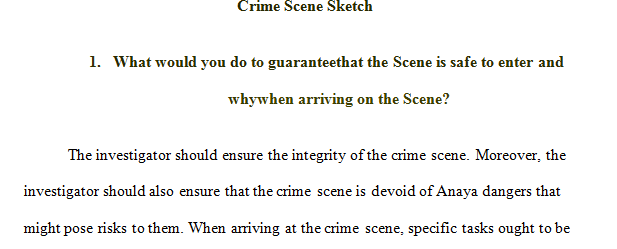When arriving on scene, what would you do to ensure that the scene is safe to enter and why?
Crime Scene Sketch
Directions: Answer each of the following questions as thoroughly as possible. After completing your crime scene sketch, please take a picture with your cell phone or other camera and upload it when turning in your assignment.
1. When arriving on scene, what would you do to ensure that the scene is safe to enter and why?
2. Explain the need for the preliminary survey and why is it important concerning the integrity of the evidence?
3. Explain how you would document a crime scene through photography of an inside room, and then of a vehicle. Complete a crime scene sketch using the following information and instructions:
a. Before collecting evidence, before moving the corpse, before any other action can be taken, you must prepare a complete and accurate record of the crime scene. This includes documentation of the location of all evidence (from the body of a victim to tiny blood drops on a wall) as well as a written account of the crime scene. The primary record is NOTES and a crime scene sketch. The secondary record are photographs. b. Instructions: You are part of the CSU team that has just been called to 875 South Bundy Drive in the Brentwood area of Los Angeles, California. It is 12:15 AM on Friday June 12, 2020. Your job is to take all of the information contained in the rough sketch and create a finished sketch that can be presented as evidence in court. c. Note the following:
The diagram establishes permanent record of items, conditions, and distance/size relationships – diagrams supplement photographs. Rough sketch is drawn at scene (normally not drawn to scale) and is used as a model for finished sketch. All of the following should be found on the finished sketch:
Title containing:
o Specific location of the scene (street address) O Date of the crime o Time (approximate time crime was committed) O Case Number O Your Name the Artist) o Weather conditions (raining, clear, windy) o Lighting conditions (bright sunlight, dark moonless night, lamps turned on/off) Key containing:
o Scale (EX 1 inch = 4.5 feet) O Compass orientation with North indicated o Evidence (exact locations and conditions where each piece of observable evidence was found) Number and Description of each piece of evidence
• Distances from fixed objects to locations of body, or other evidence.
• Evidence should be numbered on sketch. How you complete the sketch:
Answer preview when arriving on scene, what would you do to ensure that the scene is safe to enter and why?
APA
862 words

